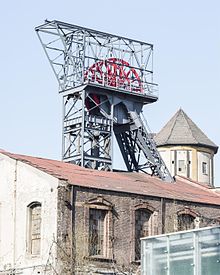Kopalnia Węgla Kamiennego Katowice
The Katowice Mine (Polish Kopalnia Węgla Kamiennego Katowice ; German name Ferdinand ) was a hard coal mine in Katowice - Bogucice , Poland.
history
Initially called Ferdinand, the mine was named Katowice from 1936.
Ferdinand pit
After initial speculations in 1822 (Ferdinand field) and 1841 (Bertram field), the mine was consolidated on August 9, 1844. Later the fields Belle Alliance, Belle Alliance II, Arthur, Pfarrfeld and Kattowitz were added, so that the authorized persons totaled 6.47 km².
The original name of the Ferdinand colliery refers to that of the retired Captain Ignatius Ferdinand von Beyma, who lived in Tarnowitz and who carried out the first investigations on hard coal in Bogutschütz. His first employees were not local people, but specialists from Wałbrzych, Westphalia, Olkusz and Wieliczka. After several changes of ownership, the mine finally came into the possession of Marie Winckler, b. Valeska, and thus in the next generation in the Kattowitzer AG for mining and ironworks . This AG included u. a. also the mines Florentine , Neu Przemba , Carlssegen / Karol and Mysłowice .
The mining, which began in 1824, was initially a tunnel mining that had to struggle with strong water inflows from the start. These were so strong that the pit drowned in 1875.
After extensive modernization measures, the transition to shaft excavation and the decline in water inflows to 8 m³ per minute, operations were resumed in 1889.
In 1912, the mine three conveying and four weather shafts which possessed production wells Benjamin (291 m deep; already in 1834 as a reel shaft) and Gruschka and Mauve (both 473 m deep) and the four weather shafts Heinrich (190 m), Norma (194 m; also material shaft), Ludwig (125 m) and Richard (342 m; also rope ride). This year there were three conveyor levels II (286 m), III (390 m) and IV (463 m), on which 1.07 million tons of coal could be extracted.
During the First World War, both women and prisoners of war were employed. In 1929, the colliery was able to acquire further mine fields. In 1936 her name was changed to Katowice.
CHP Katowice
On July 15, 1936, the Ferdinand colliery changed its name to Katowice and in 1937, like all other mines of the Kattowitzer AG für Bergbau und Metallurgie, became the property of IG Bergbau und Metallurgie, in which the Polish state held 97% of all shares. During the German occupation in World War II, the mine was operated by the Reichswerke Hermann Göring and was given the old name Ferdinand back.
Katowice was liberated by the Red Army on January 27, 1945, and the first coal transports left the mine in the direction of Warsaw on January 30.
On July 1, 1996, the KWK Katowice and Kleofas collieries were merged. The mine was closed in 1999 after 176 years of operation. During this time, more than 120 million tons of hard coal have been mined. Finally, the four shafts Gwarek , Warszawa (old name Nottebohm) and Bartosz I / II (Bartosz I = Benjamin) were located on the central area of the colliery in Bogucice . A single shaft 810 m further east was named Bogucice. In 2001, numerous daytime facilities were demolished, while others were turned into museums.
Stalinogród
In the period from 1953 to 1956 the mine was called Stalinogród; The city of Katowice also bore Stalin's name during this period.
Funding figures
1873: 72,700 tons; 1913: 1.06 million t; 1938: 834,775 t; 1970: 1.62 million t; 1979: 1.90 million t
present
Today the Silesian Museum ( Muzeum Śląskie ) is located on the former colliery site. This enabled the headframes above the Warszawa and Bartosz I shafts to be preserved and restored. Numerous daytime facilities were integrated into the overall concept of the museum.
literature
- Jerzy Jaros: Słownik historyczny kopalń węgla na ziemiach polskich. Katowice 1984.
- Yearbook for the Upper Mining District Wroclaw. Phoenix Publishing House. Katowice, Breslau, Berlin. 1913. Digitized version at http://www.dbc.wroc.pl/dlibra/publication?id=3349&tab=3 before (last accessed on May 5, 2015)
- Kurt König: The coal mining in Upper Silesia from 1945–1955. Scientific contributions to the history and regional studies of Eastern Central Europe. Published by the Johann Gottfried Herder Institute. Marburg 1958.
Web links
- An excellent presentation of the mine and its history can be found on the Polish Wikipedia page pl: Kopalnia Węgla Kamiennego "Katowice" . The German version owes a lot to this template.
- At the Internet address http://igrek.amzp.pl/mapindex.php?cat=FLOTZKARTOS (last accessed on July 14, 2015) you can find 43 flötz maps (sic) of the Upper Silesian coal basin as JPG files, the field boundaries, seams and shafts show in excellent quality after the stock from 1902. These cards were made by the “Verlag von Priebatsch's Buchhandlung. Breslau ”published.
- German website of the museum (last accessed on September 28, 2015)
Coordinates: 50 ° 15 ′ 51.6 ″ N , 19 ° 1 ′ 59.9 ″ E


